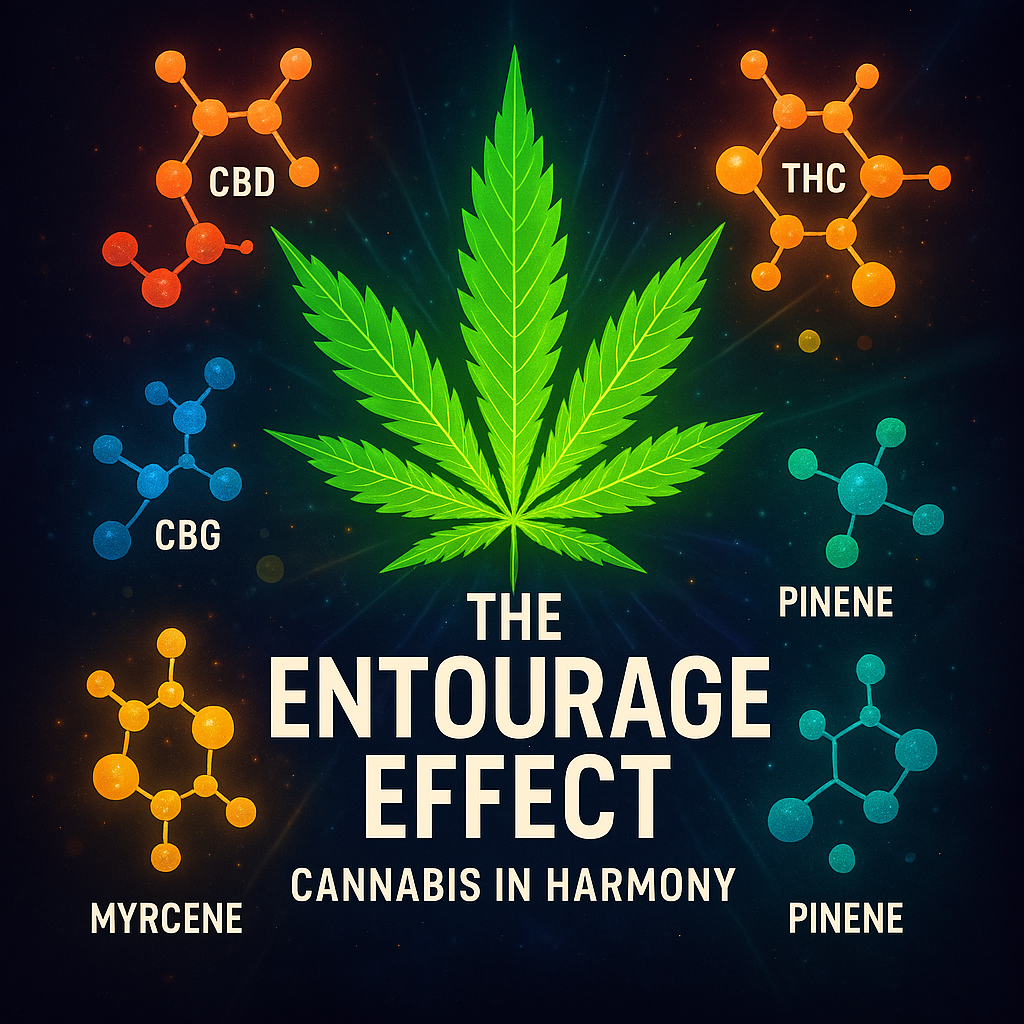The Entourage Effect
Deconstructing the Symphony of Cannabis Science
To comprehend the intricate interactions that define the cannabis experience, one must first understand the biological stage upon which these interactions occur and the cast of chemical actors involved. The human body possesses a sophisticated signaling network, the Endocannabinoid System, uniquely receptive to the compounds produced by the Cannabis sativa plant. This guide examines this system and the plant's key phytochemicals—cannabinoids, terpenes, and flavonoids—that together orchestrate its complex effects.
A Critical Warning:
The chemical complexity that drives the Entourage Effect also creates a significant risk of drug-drug interactions. Cannabis compounds can alter how your body processes prescription medications. Consult a physician or pharmacist before using any cannabis product, especially if you take other medications.
Part 1: The Foundation: The Molecules and the System
1.1 The Endocannabinoid System (ECS): The Body's Master Regulator
The Endocannabinoid System (ECS) is a complex cell-signaling network discovered in the early 1990s. It is a fundamental part of human physiology, crucial for maintaining homeostasis—a stable internal balance—across many bodily functions. The ECS is active in everyone, regardless of cannabis use, and its discovery revealed a new dimension of intercellular communication that cannabis compounds are uniquely equipped to influence.
1.2 The Cast of Compounds: A Phytochemical Overview
The Cannabis sativa plant is a complex phytochemical factory, producing over 540 chemical compounds. These are primarily synthesized in the plant's glandular trichomes—the tiny, crystalline structures on the flowers. The three principal classes of compounds involved in the Entourage Effect are cannabinoids, terpenes, and flavonoids.
Part 2: The Theory: The Entourage Effect Unveiled
2.1 Defining the Entourage Effect
The term "Entourage Effect" was first introduced in 1998 by Israeli scientists Shimon Ben-Shabat and Raphael Mechoulam. Their research was on the body's own endocannabinoid system, not the cannabis plant. They found that inactive molecules acted as an "entourage" to enhance the effects of an active one. This concept was later applied to the cannabis plant, evolving into the modern theory of "whole-plant synergy."
The modern interpretation posits that the full spectrum of compounds in cannabis—cannabinoids, terpenes, and flavonoids—work together synergistically to produce a therapeutic effect that is greater than the sum of its individual parts.
2.2 Mechanisms of Synergy
- Multi-target Effects: Compounds act on multiple biological targets simultaneously to address a complex condition from several angles.
- Pharmacokinetic Interactions: Compounds influence how the body absorbs, distributes, and metabolizes each other, altering concentration and duration of action.
- Direct Receptor-Level Interactions: Compounds directly influence how other compounds bind to and activate receptors (e.g., CBD tempering THC's effects).
- Modulation of Adverse Events: Certain compounds mitigate the undesirable side effects of others, improving the therapeutic window.
Part 3: The Application: A Guide for the Informed Consumer
3.1 Debunking the Myth: Indica vs. Sativa
For decades, consumers used "Indica" vs. "Sativa" to predict effects. This model is an outdated and scientifically inaccurate relic. Modern science shows no reliable chemical patterns that align with these labels. The actual effects are dictated by a plant's unique chemovar—its specific profile of cannabinoids and terpenes. A strain high in the sedative terpene myrcene will likely be relaxing ("Indica-like"), while one rich in the uplifting terpene limonene will be energetic ("Sativa-like").
3.2 The Modern Compass: How to Read a Certificate of Analysis (COA)
The Certificate of Analysis (COA) is the single most important tool for the modern cannabis consumer. It is a lab report from an independent, third-party lab that details a product's chemical content and confirms its safety. It allows a consumer to make a data-driven purchasing decision based on the actual chemical profile.
- Cannabinoid Profile: Verifies the potency of THC, CBD, and minor cannabinoids.
- Terpene Profile: Identifies the specific aromatic compounds that shape the product's nuanced effects.
- Contaminant Testing: Ensures the product is free from pesticides, heavy metals, residual solvents, and microbes.
Key Compounds At a Glance
Major & Minor Cannabinoids
| Compound | Commonly Associated Effects |
|---|---|
| THC | Psychoactive, analgesic, anti-emetic, appetite stimulant. |
| CBD | Non-intoxicating, anti-anxiety, anti-inflammatory, anti-seizure. |
| CBG | Anti-inflammatory, neuroprotective, antibacterial. |
| CBN | Mildly psychoactive, associated with sedative effects (research is mixed). |
| CBC | Anti-inflammatory, analgesic, potential antidepressant properties. |
| THCV | Appetite suppressant (low dose), stimulating, psychoactive (high dose). |
Common Terpenes
| Terpene | Aroma & Associated Effects |
|---|---|
| Myrcene | Earthy, musky. Associated with sedative, relaxing ("Indica-like") effects. |
| Limonene | Citrus. Associated with mood-elevation, stress relief, and energy ("Sativa-like"). |
| Pinene | Pine. Associated with alertness, memory retention, and focus. |
| Linalool | Floral (lavender). Known for calming, anti-anxiety, and sedative properties. |
| Beta-Caryophyllene | Pepper, spice. Binds to CB2 receptors; potent anti-inflammatory and analgesic. |

